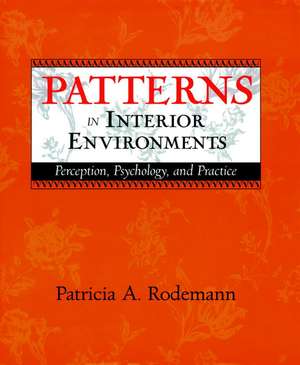Patterns in Interior Environments – Perception, Psychology & Practice
Autor PA Rodemannen Limba Engleză Hardback – 11 apr 1999
Preț: 577.17 lei
Preț vechi: 835.11 lei
-31% Nou
110.44€ • 115.60$ • 91.92£
Carte indisponibilă temporar
Specificații
ISBN-10: 0471241628
Pagini: 272
Dimensiuni: 208 x 259 x 21 mm
Greutate: 0.79 kg
Ediția:Revised and Exp.
Editura: Wiley
Locul publicării:Hoboken, United States
Public țintă
Interior Designers (both residential and commercial), Students of Interior Design – both freshmen (Interiors I, Beginning Design) and upper level courses (Materials and Sources, and Surface Design), Architects, Facility Managers, Building Owners, Textile Designers, Graphic Designers, Product Designers.Descriere
It's no secret that patterns and combinations of patterns in an interior design can produce a broad variety of physical, emotional, and psychological responses in those who view them-from cheerfulness and a desire to get things done to agitation or lethargy. Few interior designers, however, have a strong grasp of how and why these responses are produced and which types of patterns are most likely to evoke a specific reaction. Even less is known about pattern preferences among different demographic groups. Most studies available on these subjects are purely academic, largely theoretical, or devoid of any reference to practical application.
Patterns in Interior Environments is the first book to present significant original research on pattern preferences and responses with a view toward practical application by working design professionals. It offers a wealth of clear and accessible information in an easy-to-use format that will help designers better understand and respond to their clients' needs. Supplemented with hundreds of illustrations of pattern designs and patterns within room settings, this revolutionary new resource:
* Interprets and explains technical information about the psycho-physical and psychological effects of different types of patterns and public perceptions of them
* Includes recent research findings identifying pattern preferences of different demographic groups
* Specifies appropriate pattern types for various activities, including selling, learning, healing, relaxing, eating, negotiating, performing complex tasks, and more.
For residential and commercial interior designers, Patterns in Interior Environments is a powerful tool for reducing the time and frustration involved in finding patterns to meet client requirements.
The most important design tool since the swatch-a revolutionary guide to understanding pattern use and effects.
If, like most interior designers, you have spent countless hours helping clients sift through hundreds of samples in search of patterns that are just right for them, you probably wish that there were some way to know in advance which types of patterns will most appeal to a particular type of person or provide a specific benefit. There is. Wouldn't it also be helpful to understand which patterns help people enjoy a meal, recover from an illness, concentrate on a difficult task, or relax after a hard day's work?
Patterns in Interior Environments is a powerful new resource that translates cutting-edge research on the impact and perception of patterns into practical information that can be applied directly to design practice. Patricia Rodemann presents and explains the latest research findings that identify pattern preferences for a variety of demographic groups. She details the emotional, physical, and psychological effects of different types of patterns, and identifies appropriate patterns for various activities. You'll learn everything you need to know about:
* Who selects which types of patterns
* How the eyes and brain process patterns
* Pattern rules, principles, and techniques
* Color combination, preferences, and pattern
* Working with pattern for specific effect.
Patterns in Interior Environments lets you zero in on your clients' needs and preferences by asking just a few simple questions-saving time and reducing frustration while enhancing customer satisfaction.
